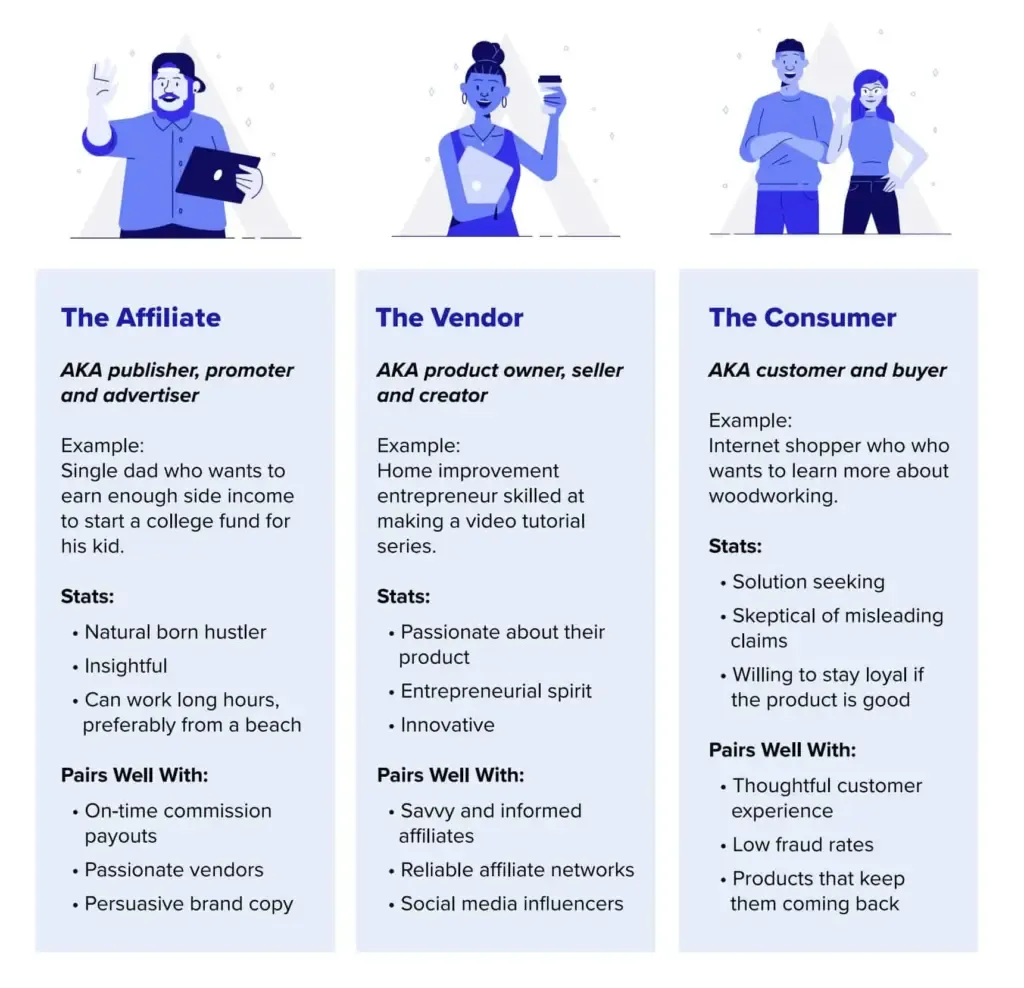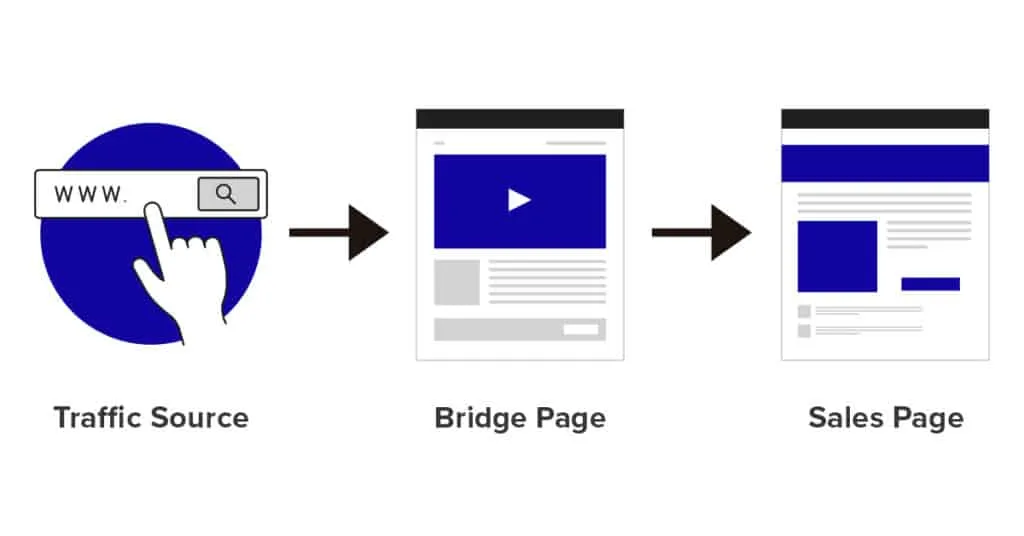One of the best things you can do for your online business aspirations (and your passive income goals) is learn how to become an affiliate marketer.
Affiliate marketing is one of those things… a lot of people kind of get it, but few people can actually describe the process completely and accurately. Go to Google for answers about affiliate marketing and you might end up more confused than when you started.
Luckily, ClickBank is an affiliate network that’s been around for more than 27 years (basically as long as the internet, if you want us to feel old) – so we know a thing or two about affiliate marketing. In this guide, we’ll cover all the basics of affiliate marketing for you!
What is Affiliate Marketing?
Affiliate marketing is an arrangement between a seller and an affiliate to offer commissions in exchange for impressions, leads, and/or sales generated from their referrals.

This process has three key players:
- The seller (i.e. merchant or vendor)
- The affiliate (i.e. publisher or partner)
- The customer (i.e. buyer)
The seller (sometimes known as a merchant, e-commerce brand, or product owner) is the one with a product to sell. They are absolutely essential to the entire affiliate marketing process – because without a product, there is nothing for affiliates to promote or for customers to buy!
The affiliate (sometimes known as a publisher or influencer) is an individual who is referring a product through online promotions. Typically, affiliates are only paid commission on sales that they facilitate from content or ads they publish online.
Common traffic sources for affiliate marketing can include emails, blogs, social media posts, discussion forum posts, online community posts, and paid ad campaigns. Like the seller, the affiliate is also needed for the affiliate marketing system to work.
The customer is the final (and most important piece) of the affiliate marketing system. The customer is to the affiliate marketing system what water is to a mill. You can build the mechanism, but it will not yield productivity without water moving through it.
No one else makes money unless there are customers eager to buy these products.
And sometimes, we have the affiliate network as a player. The network is like a broker that facilitates the connection between the seller and the affiliate. When an affiliate joins the affiliate network, they gain access to top affiliate programs offered by sellers – and when sellers join the network, they gain access to affiliates who are willing to promote their product for a commission. The network is not an essential element, but it streamlines the process for everyone else so they can focus on their own piece of the puzzle.
Once you understand the key players and their roles, affiliate marketing makes more sense. Because there are economic incentives offered to all involved, it behooves everyone to work hard and attract more customers to convert more sales!
With all this in mind, you may be wondering how affiliate marketing got started in the first place…
A Brief History of Affiliate Marketing
Affiliate marketing has been around a lot longer than people think.
In 1994, only four years after the advent of the internet, William J. Tobin launched PC Flowers and Gifts and developed the business model for paying a commission on e-commerce sales. In 1996, he applied for a patent on tracking and affiliate marketing. Since then, the industry has evolved immensely.
Since A-listers like Amazon and Geffen Records kicked things off and set the precedent for affiliate marketing in the 1990s, businesses have been striving to make this particular market and income-earning arena accessible to laymen for more than thirty years.
And now, more so than ever, it is…
Anybody – literally anybody – can be an affiliate marketer.
But like anything worth doing, success comes with trial, error, and hard work!
How to Get Started as an Affiliate Marketer
Now that you know what it is and how it came to be, are you ready to get started as an affiliate marketer?
Here’s the “must have” step-by-step checklist to consider as you begin:
1) Realistic Expectations
Contrary to what some websites or “gurus” may claim, you’re not going to make thousands of dollars on your first day as an affiliate marketer.
You might make $7.
But it’s more likely that you make $0 – at least at first.
It’s important to approach affiliate marketing with an eye on the long game. Knowing that success in affiliate marketing requires momentum, resilience, and dedication will help you manage the inevitable setbacks along the way and keep you going when you’re feeling discouraged.
Because the reality is, affiliate marketing is a lot of different skills bundled together – copywriting, page building, graphic design, video editing – and you’ll need them all working in tandem to find affiliate success with your content or campaigns.
2) An Affiliate Landing Page
You might get frustrated if you’re trying to figure out how to get a landing page up and running and make money as an affiliate marketer at the same time.
Before you get too far into the process, it’s important to recognize that nothing happens without a functioning space online to place your affiliate tracking links.
Because this specialized landing page serves as a bridge between a particular traffic source and the sales page where a customer can buy the affiliate product, you’ll also see it called a bridge page. (Learn more about affiliate bridge pages.)

Ultimately, you may point traffic to this page from a link in your social media bio, a YouTube description, a blog post, an email, or a paid campaign – but you’ll need your own landing page for any affiliate marketing strategy to work.
Luckily, ClickBank can help you in this department with our own funnel builder, ClickBank Accelerator. Click the link to learn more!
3) Some Skin in the Game (Free Traffic or Paid Traffic)
All business involves both reward and risk.
The potential reward of time and location freedom is why affiliate marketing is so appealing – but once you put money or time into something, the stakes immediately get higher too.
So, pick your poison.
If you want to keep costs low, treat your time like a commodity and build an organic presence on social media or with an SEO blog (free traffic).
If you have the funds, run ads (paid traffic) to promote top affiliate products.
Or if you’re all-in, find a way to invest time AND money into your affiliate marketing business. Just choose a way to up the ante for yourself and play this game like you have something to lose!
4) Stoke
If you’re going to get into affiliate marketing, you have to bring the excitement.
People want to buy products that are life-changing. If you’re not the Don Draper of creating content or ads, you’re going to need to find a niche that you get absolutely stoked over when you tell your friends about it.
This enthusiasm will translate into everything you produce and compel customers to buy, which means more affiliate commissions ($$$) for you!
5) A Trusted Affiliate Network
Of course, you can try to be an affiliate marketer without an affiliate network, but nobody in the industry would recommend it.
A network is not essential to the affiliate marketing process in the same way you could light your house with candles, but why not just use electricity instead?
For one, connecting with sellers through a network is a thousand times safer; and two, there is an obvious and highly accessible better way to achieve the objective.
Since affiliate marketing is becoming more mainstream, there are several affiliate networks to choose from. You’ll want to pick one that’s trusted and established.
ClickBank is both of those things. We’ve been doing this for a long time, so we know how to do it right.
We know affiliate marketing.
If you’re ready to get started, we encourage you to sign up for a FREE ClickBank account!
We’ll see you in the marketplace.









